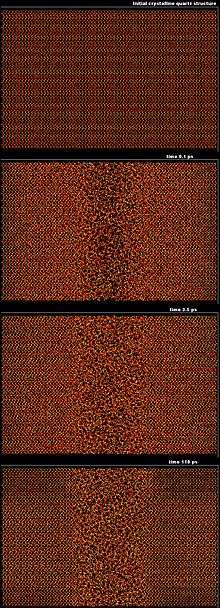Swift heavy ion
Swift heavy ions are a special form of particle radiation for which electronic stopping dominates over nuclear stopping.[1][2] They are accelerated in particle accelerators to very high energies, typically in the MeV or GeV range and have sufficient energy and mass to penetrate solids on a straight line. In many solids swift heavy ions release sufficient energy to induce permanently modified cylindrical zones, so-called ion tracks. If the irradiation is carried out in an initially crystalline material, ion tracks consist of an amorphous cylinder.[1] Ion tracks can be produced in many amorphizing materials, but not in pure metals, where the high electronic heat conductivity dissipates away the electronic heating before the ion track has time to form.
Mechanisms

The mechanisms by which ion tracks are produced are subject to some debate. They can in some sense considered to produce thermal spikes[3][4] in the sense that they lead to strong lattice heating and a transient disordered atom zone. However, at least the initial stage of the damage might be better understood in terms of a Coulomb explosion mechanism.[5] Regardless of what the heating mechanism is, it is well established that swift heavy ions typically produce a long cylindrical track of damage in insulators,[1][3] which has been shown to be underdense in the middle at least in SiO2.[6][7]
Applications
Swift heavy ion tracks have several established and potential practical applications. Ion tracks in polymers can be etched to form a nanometer-thin channel through a polymer foil, so called track etch membranes. These are in industrial use.[8]
Irradiation of polyimide resists have potential to be used as templates for nanowire growth.[9] Tracks can also be used to sputter materials.[10][11] They can also be used to elongate nanocrystals embedded in materials.[12][13][14]
References
- Kanjijal, D. (2001). "Swift heavy ion-induced modification and track formation in materials" (DjVu). Current Science. 80 (12): 1560.
- M. Toulemonde, W. Assmann, C. Dufour, A. Meftah, F. Studer, and C. Trautmann, Experimental phenomena and thermal spike model description of ion tracks in amorphisable inorganic insulators, Mat. Fys. Medd. Kong. Dan. Vid. Selsk. 52, 263 (2006).
- Meftah, A.; Brisard, F.; Costantini, J. M.; Dooryhee, E.; Hage-Ali, M.; Hervieu, M.; Stoquert, J. P.; Studer, F.; Toulemonde, M. (1 April 1994). "Track formation in SiO2 quartz and the thermal-spike mechanism". Physical Review B. American Physical Society (APS). 49 (18): 12457–12463. doi:10.1103/physrevb.49.12457. ISSN 0163-1829. PMID 10010146.
- Trautmann, C.; Klaumünzer, S.; Trinkaus, H. (23 October 2000). "Effect of Stress on Track Formation in Amorphous Iron Boron Alloy: Ion Tracks as Elastic Inclusions" (PDF). Physical Review Letters. American Physical Society (APS). 85 (17): 3648–3651. doi:10.1103/physrevlett.85.3648. ISSN 0031-9007. PMID 11030972.
- Bringa, E. M.; Johnson, R. E. (4 April 2002). "Coulomb Explosion and Thermal Spikes". Physical Review Letters. American Physical Society (APS). 88 (16): 165501. arXiv:cond-mat/0103475. doi:10.1103/physrevlett.88.165501. ISSN 0031-9007. PMID 11955237.
- Kluth, P.; Schnohr, C. S.; Pakarinen, O. H.; Djurabekova, F.; Sprouster, D. J.; Giulian, R.; Ridgway, M. C.; Byrne, A. P.; Trautmann, C.; Cookson, D. J.; Nordlund, K.; Toulemonde, M. (24 October 2008). "Fine Structure in Swift Heavy Ion Tracks in AmorphousSiO2". Physical Review Letters. American Physical Society (APS). 101 (17): 175503. doi:10.1103/physrevlett.101.175503. hdl:10440/862. ISSN 0031-9007. PMID 18999762.
- Kaniukov, E Yu; Ustarroz, J; Yakimchuk, D V; Petrova, M; Terryn, H; Sivakov, V; Petrov, A V (15 February 2016). "Tunable nanoporous silicon oxide templates by swift heavy ion tracks technology". Nanotechnology. IOP Publishing. 27 (11): 115305. doi:10.1088/0957-4484/27/11/115305. ISSN 0957-4484. PMID 26878691.
- Apel, P. (2003). "Swift ion effects in polymers: industrial applications". Nuclear Instruments and Methods in Physics Research Section B: Beam Interactions with Materials and Atoms. Elsevier BV. 208: 11–20. doi:10.1016/s0168-583x(03)00634-7. ISSN 0168-583X.
- Skupinski, Marek; Toulemonde, Marcel; Lindeberg, Mikael; Hjort, Klas (2005). "Ion tracks developed in polyimide resist on Si wafers as template for nanowires". Nuclear Instruments and Methods in Physics Research Section B: Beam Interactions with Materials and Atoms. Elsevier BV. 240 (3): 681–689. doi:10.1016/j.nimb.2005.04.128. ISSN 0168-583X.
- Urbassek, H. M.; Kafemann, H.; Johnson, R. E. (1 December 1993). "Atom ejection from a fast-ion track: A molecular-dynamics study". Physical Review B. American Physical Society (APS). 49 (2): 786–795. doi:10.1103/physrevb.49.786. ISSN 0163-1829.
- Toulemonde, M.; Assmann, W.; Trautmann, C.; Grüner, F.; Mieskes, H.D.; Kucal, H.; Wang, Z.G. (2003). "Electronic sputtering of metals and insulators by swift heavy ions". Nuclear Instruments and Methods in Physics Research Section B: Beam Interactions with Materials and Atoms. Elsevier BV. 212: 346–357. doi:10.1016/s0168-583x(03)01721-x. ISSN 0168-583X.
- D’Orléans, C.; Stoquert, J.P.; Estournès, C.; Grob, J.J.; Muller, D.; Guille, J.L.; Richard-Plouet, M.; Cerruti, C.; Haas, F. (2004). "Elongated Co nanoparticles induced by swift heavy ion irradiations". Nuclear Instruments and Methods in Physics Research Section B: Beam Interactions with Materials and Atoms. Elsevier BV. 216: 372–378. doi:10.1016/j.nimb.2003.11.063. ISSN 0168-583X.
- Ridgway, M.C.; Kluth, P.; Giulian, R.; Sprouster, D.J.; Araujo, L.L.; Schnohr, C.S.; Llewellyn, D.J.; Byrne, A.P.; Foran, G.J.; Cookson, D.J. (2009). "Changes in metal nanoparticle shape and size induced by swift heavy-ion irradiation". Nuclear Instruments and Methods in Physics Research Section B: Beam Interactions with Materials and Atoms. Elsevier BV. 267 (6): 931–935. doi:10.1016/j.nimb.2009.02.025. ISSN 0168-583X.
- Awazu, Koichi; Wang, Xiaomin; Fujimaki, Makoto; Tominaga, Junji; Aiba, Hirohiko; Ohki, Yoshimichi; Komatsubara, Tetsuro (6 August 2008). "Elongation of gold nanoparticles in silica glass by irradiation with swift heavy ions". Physical Review B. American Physical Society (APS). 78 (5): 054102. doi:10.1103/physrevb.78.054102. ISSN 1098-0121.